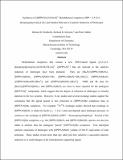Synthesis of [(DPPNCH₂CH₂)₃N]³− Molybdenum Complexes (DPP = 3,5-(2,5-Diisopropylpyrrolyl)₂C₆H₃) and Studies Relevant to Catalytic Reduction of Dinitrogen
Author(s)
Reithofer, Michael R.; Schrock, Richard Royce; Mueller, Peter
DownloadMain article (945.8Kb)
PUBLISHER_POLICY
Publisher Policy
Article is made available in accordance with the publisher's policy and may be subject to US copyright law. Please refer to the publisher's site for terms of use.
Terms of use
Metadata
Show full item recordAbstract
Molybdenum complexes that contain a new TREN-based ligand [(3,5-(2,5-diisopropyl-pyrrolyl)2C6H3NCH2CH2)3N]3− ([DPPN3N]3−) that are relevant to the catalytic reduction of dinitrogen have been prepared. They are [Bu4N]{[DPPN3N]MoN2}, [DPPN3N]MoN2, [DPPN3N]MoN═NH, {[DPPN3N]MoN═NH2}[BArf4], [DPPN3N]Mo≡N, {[DPPN3N]Mo≡NH}[BArf4], and {[DPPN3N]MoNH3}[BArf4]. NMR and IR data for [Bu4N]{[DPPN3N]MoN2} and [DPPN3N]MoN2 are close to those reported for the analogous [HIPTN3N]3− compounds (HIPT = hexaisopropylterphenyl), which suggests that the degree of reduction of dinitrogen is virtually identical in the two systems. However, X-ray studies and several exchange studies support the conclusion that the apical pocket is less protected in [DPPN3N]Mo complexes than in [HIPTN3N]Mo complexes. For example, 15N/14N exchange studies showed that exchange in [DPPN3N]MoN2 is relatively facile (t1/2 ≈ 1 h at 1 atm) and depends upon dinitrogen pressure, in contrast to the exchange in [HIPTN3N]MoN2. Several of the [DPPN3N]Mo complexes, e.g., the [DPPN3N]MoN2 and [DPPN3N]MoNH3 species, are also less stable in solution than the analogous “parent” [HIPTN3N]Mo complexes. Four attempted catalytic reductions of dinitrogen with [DPPN3N]MoN yielded 2.53 ± 0.35 equiv of total ammonia. These studies reveal more than any other just how sensitive a successful catalytic reduction is to small changes in the triamidoamine supporting ligand.
Date issued
2010-05Department
Massachusetts Institute of Technology. Department of ChemistryJournal
Journal of the American Chemical Society
Publisher
American Chemical Society
Citation
Reithofer, Michael R., Richard R. Schrock, and Peter Müller. “Synthesis of [(DPPNCH₂CH₂)₃N]³− Molybdenum Complexes (DPP = 3,5-(2,5-Diisopropylpyrrolyl)₂C₆H₃) and Studies Relevant to Catalytic Reduction of Dinitrogen.” Journal of the American Chemical Society 132.24 (2010): 8349–8358. Web.
Version: Author's final manuscript
ISSN
0002-7863
1520-5126